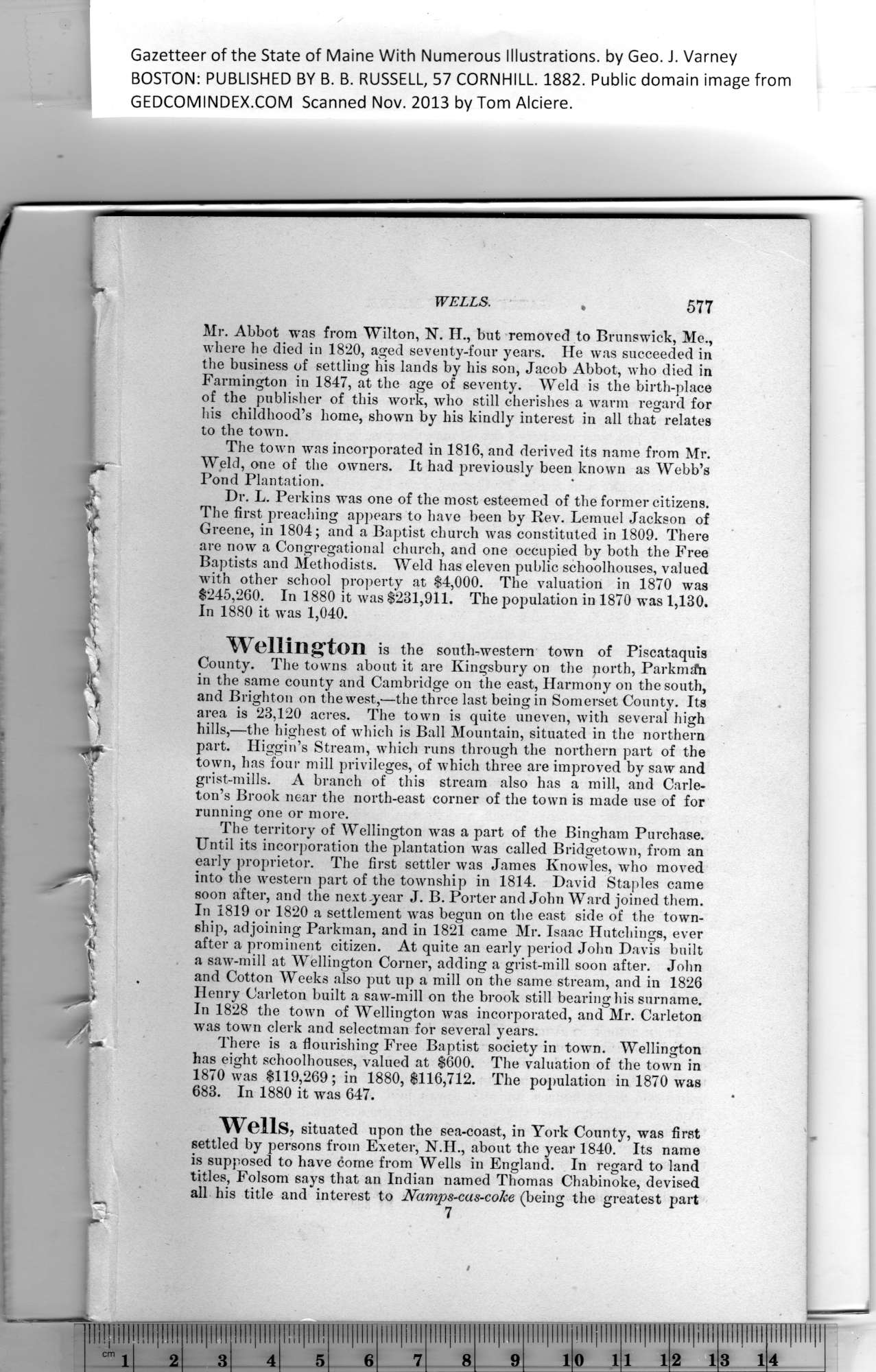|
Gazetteer of the State of Maine With Numerous Illustrations, by Geo. J. Varney
BOSTON: PUBLISHED BY B. B. RUSSELL, 57 CORNHILL. 1882. Public domain image from
r
WELLS.
Mr. Abbot w*as from Wilton, N. H., hut removed to Brunswick, Me.,
where he died in 1820, aged seventy-four years. He was succeeded in
the business of settling his lands by his son, Jacob Abbot, who died in
Farmington in 1847, at the age of seventy. Weld is the birth-place
of the publisher of this work, who still cherishes a warm regard for
his childhood’s home, shown by his kindly interest in all that relates
to the town.
The town was incorporated in 1816, and derived its name from Mr.
Weld, one of the owners. It had previously been known as Webb’s
Pond Plantation.
Dr. L. Perkins was one of the most esteemed of tbe former citizens.
The first preaching appears to have been by Rev. Lemuel Jackson of
Greene, in 1804; and a Baptist church was constituted in 1809. There
are now a Congregational church, and one occupied by both the Free
Baptists and Methodists. Weld has eleven public schoolhouses, valued
with other school property at $4,000. The valuation in 1870 was
$245,260. In 1880 it was $231,911. The population in 1870 was 1,130.
In 1880 it was 1,040.
Wellington is the southwestern town of Piscataquis
County. The towns about it are Kingsbury on the north, Parkmsfh
in the same county and Cambridge on the east, Harmony on the south,
and Brighton on the west,-—the three last being in Somerset County. Its
area is 23,120 acres. The town is quite uneven, with several high
hills,—the highest of which is Ball Mountain, situated in the northern
part. Higgin’s Stream, which runs through the northern part of the
town, has four mill privileges, of which three are improved by saw and
grist-mills. A branch of this stream also has a mill, and Carle-
ton’s Brook near the north-east corner of the town is made use of for
running one or more.
The territory of Wellington was a part of the Bingham Purchase.
Until its incorporation the plantation was called Bridgetown, from an
early proprietor. The first settler was James Knowles, who moved
into the western part of the township in 1814. David Staples came
soon after, and the next year J. B. Porter and John Ward joined them.
In 1819 or 1820 a settlement wras begun on the east side of the town-
ship, adjoining Parkman, and in 1821 came Mr. Isaac Hutchings, ever
after a prominent citizen. At quite an early period John Davis built
a saw-mill at Wellington Corner, adding a grist-mill soon after. John
and Cotton Weeks also put up a mill on the same stream, and in 1826
Henry Carleton built a saw-mill on the brook still bearing his surname.
In 1828 the town of Wellington was incorporated, and Mr. Carleton
was town clerk and selectman for several years.
There is a flourishing Free Baptist society in town. Wellington
has eight schoolhouses, valued at $600. The valuation of the town in
1870 was $119,269; in 1880, $116,712. The population in 1870 was
683. In 1880 it was 647.
Wells, situated upon the sea-coast, in York County, was first
settled by persons from Exeter, N.H., about the year 1840. Its name
is supposed to have come from Wells in England. In regard to land
titles, Folsom says that an Indian named Thomas Chabinoke, devised
all his title and interest to Namps-cas-coke (being the greatest part
7
PREVIOUS PAGE ... NEXT PAGE
This page was written in HTML using a program written in Python 3.2
|
